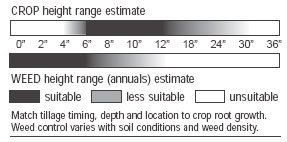Horticultural Crops
Rotary Tillers (convertible to cultivating)

Overview: Rotary tillers have blades anchored on rotors that are bolted directly to a single horizontal power shaft that is 8" to 12" above the soil surface. For row-crop weeding they are more expensive and require more maintenance compared with sweep cultivators. They can be operated faster than sweeps in crusted soil, but would be slower in normal conditions. However, tillers are more adaptable to other tillage roles and may reduce field passes by incorporating residue, forming beds and creating a seed bed in a single pass. Uses include strip-planting into cover crops, preparing permanent planting beds, renovating strawberry plantings and incorporating compost or soil-applied herbicides. Blade length limits the height of the crop that will pass unharmed under the solid drive shaft. Visibility of the working area limited by tool cover.

Design Features: Rotors must be selectively removed or adjusted to do inter-row weeding - at least a two-hour job. Drive shaft is PTO-powered by chain drive in most cases. One manufacturer's multiple-belt drive cushions sudden impacts. Features to check include multi-speed gearbox drive (slowest RPMs prevent soil structure damage), PTO slip clutch for chain-drive models, and depth-control mode. When working rough soils, front depth-gauge wheels don't provide as even a job as side skids or a rear crumbler/roller. Optional crop shields keep soil from flowing into row.
Blade shape varies the tool's effect. Slightly curved 'C' or angled straight blades pass most easily through heavy residue, moist soils and deeper levels. 'L' blades have a 90-degree bend and wide horizontal cutting surface for shallow undercutting of vegetation - with minimal incorporation. Blade strength, type of metal used and number of blades per rotor will influence value, effectiveness and durability.
Model for comparison: 15' toolbar working six, 30" rows (6R30)
Rec. PTO HP: 120 to 150
Speed: 1 to 6 mph
List price: $10,000 to $24,000
Width range (all makers/all models): 6' to 30'
Sources: 25, 61
Farmers: Berning
TIPS: Rule of thumb - Estimated power requirement for rotary tillers is 7 to 10 PTO horsepower per working foot for strip-tilling or cultivating.
